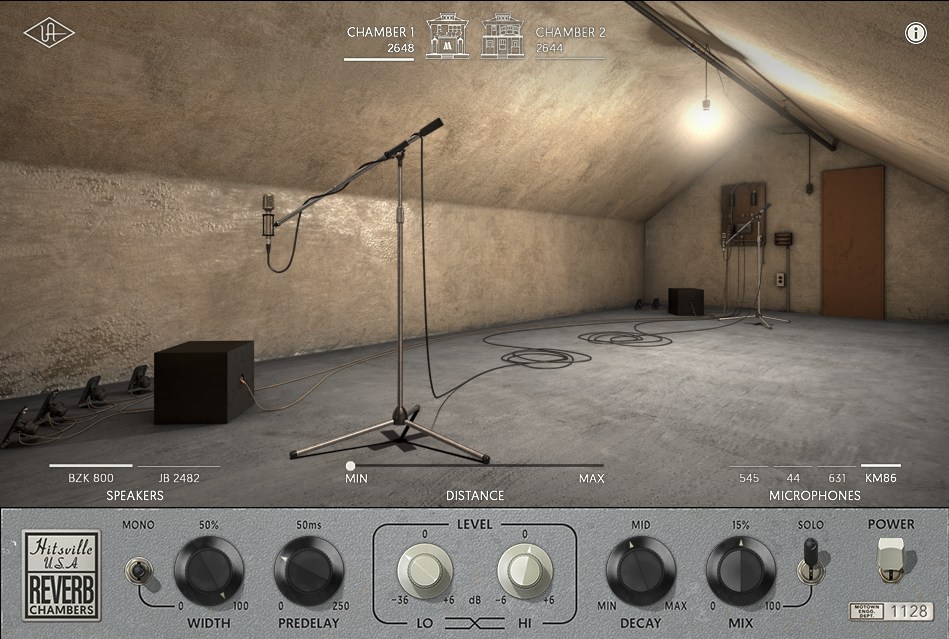Ever notice the lively ambience of vocal, drum, and instrument tracks on ’60s Motown classics? That distinctive sound is due in large part to the unique house-turned-studio purchased by Motown founder Berry Gordy, the attic of which was converted into a reverb chamber that became one of the most characterful reverb sounds ever recorded.
In this article we’ll look at why and how this reverb chamber came to be, how Universal Audio was able to recreate it, and how to use it in your mixes to bring sterile recordings to life.
What is Hitsville? – The Motown Sound
In 1959, Berry Gordy purchased a house that was converted into Motown’s Hitsville U.S.A. recording studio, where many of the biggest hits of the 1960s would soon be churned out. The engineers originally used the studio bathroom as the reverb chamber, but this became inconvenient as business picked up. Eventually a second house was purchased for studio recording duties, and the attics of both houses were converted into reverb chambers.
To recreate these legendary reverb spaces, Universal Audio undertook a serious amount of research, working with several of the original Motown engineers at the original studio (which is still intact, with both reverb chambers preserved!) and spending a year tracking down the correct vintage mics and speakers, to better create a period-accurate sound.
Related: How Motown Made It Work: Drum Recording
All eras of music teach us lessons about recording, playing, and mixing. When it comes to tracking a drum kit, something changed in the 1950s and early ’60s in Detroit, where the Motown sound was born. | Read »
The first chamber, dubbed “2648” in the plug-in because the house is located at 2648 W. Grand Blvd. in Detroit, was built in the studio’s attic by Motown founder Berry Gordy’s father, “Pop” Gordy. This was the first of the two to be built. Hitsville staff termed it an “echo chamber” because its parallel surfaces create an echo/reverb sound. These parallel walls, plus the chamber’s setup of the speakers and mics both pointed at the corner, are unusual by reverb chamber standards. But that unusual sound created a kind of audio magic that makes Motown tracks sound like Motown.
The second chamber, “2644”, was designed more conventionally by Motown engineer Mike McLean for a longer decay and deeper, more lush tonality. For the purposes of this article, we’ll focus on the unique characteristics of the 2648 chamber.
A Look at the Plug-in Interface
If you take a look at the plug-in window, you’ll see a handful of pretty simple controls. You have two sets of speakers to choose from, four microphone sets, a distance slider, Lo and Hi levels, and width, pre-delay, decay, and mix controls for the reverb. You also have mono and solo switches.

The Bozak 800s are two-way speakers with 8-inch drivers which are on the floor pointed at the corners of the room, just like the original Hitsville setup. Although unconventional, this gives you the distinctive “Motown sound.” Your other speaker option is the JB 2482, a set of narrow-band “foghorn” drivers with a very bright, loud output. These replaced the original Bozak speakers in 1968.
The Lo and Hi controls vary the amount of level feeding the speakers from each side of the crossover, letting you effectively EQ the signal feeding the speakers. The distance slider moves the mics back from the speakers for more room sound with less direct speaker sound. Pre-delay lets you delay the reverb sound which helps the reverb stay out of the way of the source track, and also can be used to create a slapback echo effect. The Decay knob is very useful, and worth playing around with to get the right reverb tail length for your source and avoid muddying up your mix. The Width knob lets you adjust the stereo spread, and you can always engage the Mono switch for a more authentic Motown sound.
The “545” mic is very similar to an SM57 — warm and natural without a huge amount of bass or treble emphasis. The “44” is the classic RCA 44 ribbon mic, with its attendant low-mid bulge and rolled-off treble for a smooth, rich sound. The “631” is a narrower-response omni mic with a decidedly vintage tonality. The “KM86” is Neumann’s coveted multi-pattern condenser, which gives you a full frequency response and different pickup patterns depending on which reverb chamber and speakers you’re using it with (for this article we’re using the 2648 chamber).
How to Use the Hitsville Reverb In Your Mixes
With its echo/reverb sound, unique resonance, and stereo movement, the “2648” reverb can do a lot to add space and excitement to your mixes, and UA’s Dynamic Room Modeling technology lets you adjust the mics, mic positions, and decay time to suit the track you’re using it on, be it vocals, drums, or whatever else.
For the sound samples below I’ve used the multitracks from a recording session I helped engineer at the Electrical Audio studio in Chicago, IL. The artist, Jake Gehdert, was kind enough to allow me to use his song “Suburbs” to illustrate the Hitsville reverb on vocals, organ, drums, and electric guitar.
To start, here’s the raw acoustic guitar, vocal, and organ, with no additional reverb:
Now listen to the same thing, but with Hitsville 2648 reverb added to the vocals and organ (the acoustic was bleeding into the vocal mic so it ends up getting some reverb too):
I sent some vocal signal to a bus with an instance of Hitsville Chambers loaded up, set to the 2648 reverb with the Bozak 800 speakers and RCA 44 ribbon mics. I left the decay on “max” and added a good amount of pre-delay so the reverb wouldn’t muddy up the vocal track too much. The distance is set to “minimum” and I reduced the Lo level a bit because some of the low-mid frequencies were creating a resonance in the reverb that was a bit unpleasant.

For the organ reverb I used the JB 2482 “foghorn” drivers. Their narrow-band response seemed to be perfect for the organ frequencies I wanted to emphasize, especially in combination with the 545 dynamic microphone. I turned the Lo control down quite a bit and also added a good amount of Hi, which with the 2482 added more midrange than treble, which suited the organ well. Decay time was left on maximum.
Organ with no reverb:
Organ with reverb added:

For the drum reverb I used the Bozak speakers again but this time with the KM86 microphones, which has some extra high-end crispiness that helped the drums pop a bit more. I reduced the decay time a lot for the drums, because at the “Max” setting things were getting too muddy. With the distance set to about 11 o’clock, the reverb time was just right to add space and excitement without sounding like the drums were in a cave. I also reduced quite a bit of Lo level and added some Hi for the same reason.
Here’s the raw drum track with no reverb:
Drums with reverb:

Now let’s hear the song with all the parts, first without any added reverb:
And here’s the same thing with the different Hitsville reverb busses on the different instruments. I fed the electric guitar into the same reverb bus I used for the vocals to add a bit of ambience to that track.
In case you’re curious, I’ve also included the vocal, drum, and organ reverbs with the wet signal only (all reverb, no raw track), so you can hear exactly what the Hitsville plug-in is doing.
Vocals, verb only:
Organ, verb only:
Drums, verb only:
As you can see, the Hitsville reverb adds a nice, natural ambience to tracks without drowning them. The Hitsville plug-in is great to use with and compare to UAD’s Capitol Chambers reverb, another plug-in that emulates a classic reverb chamber. While the Capitol Chambers excels at deep, long, rich verbs, the Hitsville is perfect for adding more room-like excitement with plenty of higher-frequency resonance and stereo information that helps featured parts stand out from the mix and glues the whole song together.
Related: Mixing With the UAD Capitol Chambers Reverb Plug-in
It’s not easy to find a software reverb that replicates the sound of a real reverb chamber. However, Universal Audio seems to have done this quite well with their Capitol Chambers reverb plug-in. Let’s get inside UAD’s Capitol Chambers and hear it in action! | Read »






Leave a Reply